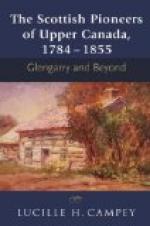Samuel Hearne started on the 6th of November, 1769, from Prince of Wales’s Fort at the mouth of the Churchill River, on the north-west coast of Hudson Bay. Presumably he and the two “common white men” who were with him travelled on snowshoes and hauled small sledges after them. Travelling westward they passed over bleak hills with very little vegetation—“the barren grounds, where, in general, we thought ourselves well off if we could scrape together as many shrubs as would make a fire; but it was scarcely ever in our power to make any other defence against the weather than by digging a hole in the snow down to the moss, wrapping ourselves up in our clothing, and lying down in it, with our sledges set up edgeways to windward”. But the principal Indian guide that he engaged was so obviously determined to make the expedition a failure that Hearne returned to his base, Prince of Wales’s Fort, and made a second start on the 23rd of February, 1770, this time taking care not to be accompanied by any other white men, and insisting that the Indians who accompanied him should be more carefully chosen.
It must be remembered that in all these early expeditions, French and English, the explorers relied for their food almost entirely on what could be obtained as they went along, in the way of venison, grouse, geese, fish, and wild fruits. In the springtime they would probably get goose eggs and some form of maple sugar through the Indians. From the summer to the autumn there would be an abundance of wild fruits and nuts, but for the rest of the year it would be a diet almost entirely of flesh or fish. As a stand-by there was probably pemmican, made in times of plenty from fish, from bison meat and fat, or from the dried flesh of deer or musk oxen; but tea, coffee, bread, biscuits, and such like accessories were absolutely unknown to them, in fact they lived exactly as the Amerindians did. Their habitations, of course, were the tents or houses of the natives, or what they made for themselves.
In order to pitch an Indian tent in winter it was first necessary to search for a level piece of dry ground, and this could only be ascertained by thrusting a stick through the snow, down to the ground, all over the proposed plot. When a suitable site had been found the snow was then cleared away down to the very moss, in the shape of a circle. When a prolonged stay was contemplated, even the moss was cut up and removed, as it was very liable when dry to catch fire. A quantity of poles were then procured, proportionate in number and length to the size of the tent cloth and the number of persons the tent was intended to contain. Two of the longest poles were tied together at the top and raised to an angle of about 45 degrees from the ground, so that the lower ends extended on either side as widely as the proposed diameter of the tent. The other poles were then arranged on either side of the first two, so that they formed a complete circle round the bottom,




